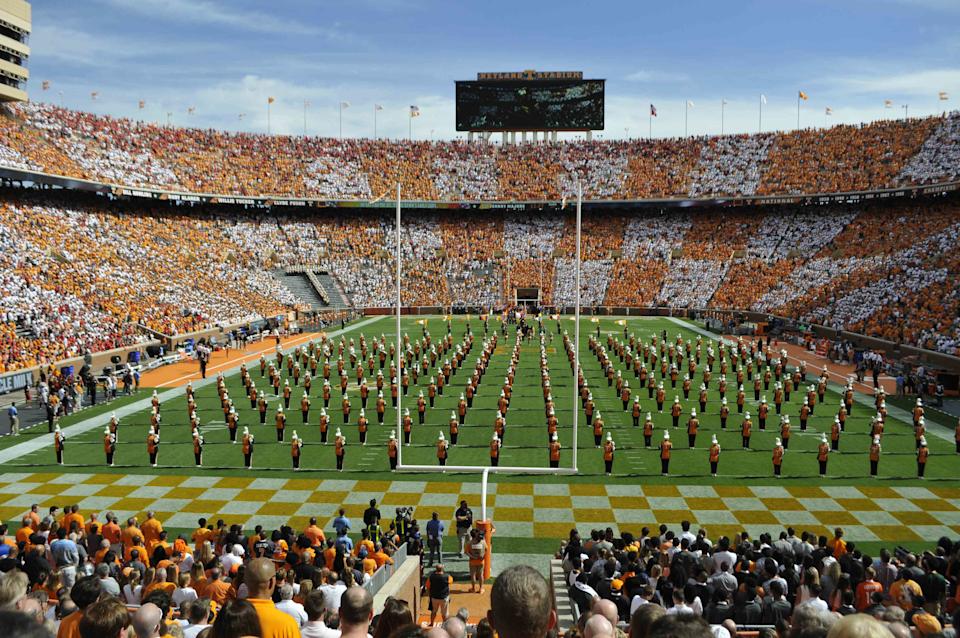How Rocky Top Became A Beloved University Of Tennessee Anthem
Before making it big in Knoxville, the University of Tennessee's signature tune was hiding on the B-side of an Osborne Brothers album.

Jeffrey Vest/Icon Sportswire via Getty Images
University of Tennessee's Pride of the Southland BandYou'll hear the uptempo favorite Rocky Top played between 40 to 50 times at any University of Tennessee football game—especially when the team is on fire.
"There's no set number," says Dr. Michael Stewart, director of Tennessee's Pride of the Southland Band. "We play it after any touchdown, any field goal or any big play. We incorporate it into our pregame show and our 'March to the Stadium' parade route. It's a tradition for the trombone section to keep track of how many times we actually play the song—and it's not unusual for the opposing team's band to count too because we do play it so often."
Originally on the B-side of an Osborne Brothers record, here's how the song became a game-day anthem for Volunteers fans.
Halftime Standout
For the record, we're talking about a song that contains only five basic chords. And a title that repeats itself 19 times. A song about a mythical place nobody's ever been, with a melody that wiggles its way into your head and stays there long after the final score is in the record books. Introduced on October 21, 1972 (yes, more than 50 years ago!), Rocky Top was merely one of many songs in a halftime medley—but the fans heard something they liked. Then-band director W. J. Julian later noted, "Not playing it [from that time forward] would cause a mutiny among Tennessee fans."
Nashville's Amy McClain Joyner, a cheerleader at that first Rocky Top game, remembers the day—and the song. "We knew it was something new and different," she says. "We coordinated our flips and steps to that rhythm. People went crazy. It's the kind of song that builds momentum in the stands. And every year it got stronger and stronger."
Birth of an Anthem
It's a small miracle the song was ever written.
Del Bryant, son of songwriters Felice and Boudleaux Bryant, has gone on record about what went on in August 1967 in Room 388 of the Gatlinburg Inn, the couple's favorite creative retreat. Felice, born in Milwaukee, was battling burnout during a writing session with her husband, a native Georgian.
"They were working on a series of [slow] songs for Archie Campbell when my mother suggested they write something peppy," Bryant has said. Reportedly, Boudleaux grabbed his guitar, and 10 minutes later Rocky Top was born.
It landed on the B-side (the generally ignored side) of a record by the Osborne Brothers, its fate doomed. Then one day, on a whim, popular deejay Ralph Emery flipped the vinyl and played the Rocky Top side. "He said, 'the phones started ringing' and the song had a life of its own after that," said Bryant. Despite the couple's major hits for the Everly Brothers and other notable artists (Wake Up, Little Susie, Bye-Bye Love, and more), Rocky Top is decidedly the most successful tune in their 800-song repertoire.
Unofficial Fight Song
Today Rocky Top, recorded again and again across the globe by performers like Dolly Parton, stands as an official Tennessee state song. While "Down the Field" is the school's official fight song, Rocky Top is widely known among fans and rivals alike. It serves to drive coaches, fans, and bands from opposing teams delightfully over the edge with its roaring crowd enthusiasm and volume.
As Rocky Top enters its sixth decade, cheerleader Amy says, "I hear it in my sleep—I just can't get it out of my head. I cannot tell you how pumped I still get when I hear Rocky Top—I'll never tire of it. Never."
For more Southern Living news, make sure to sign up for our newsletter!
Read the original article on Southern Living.

